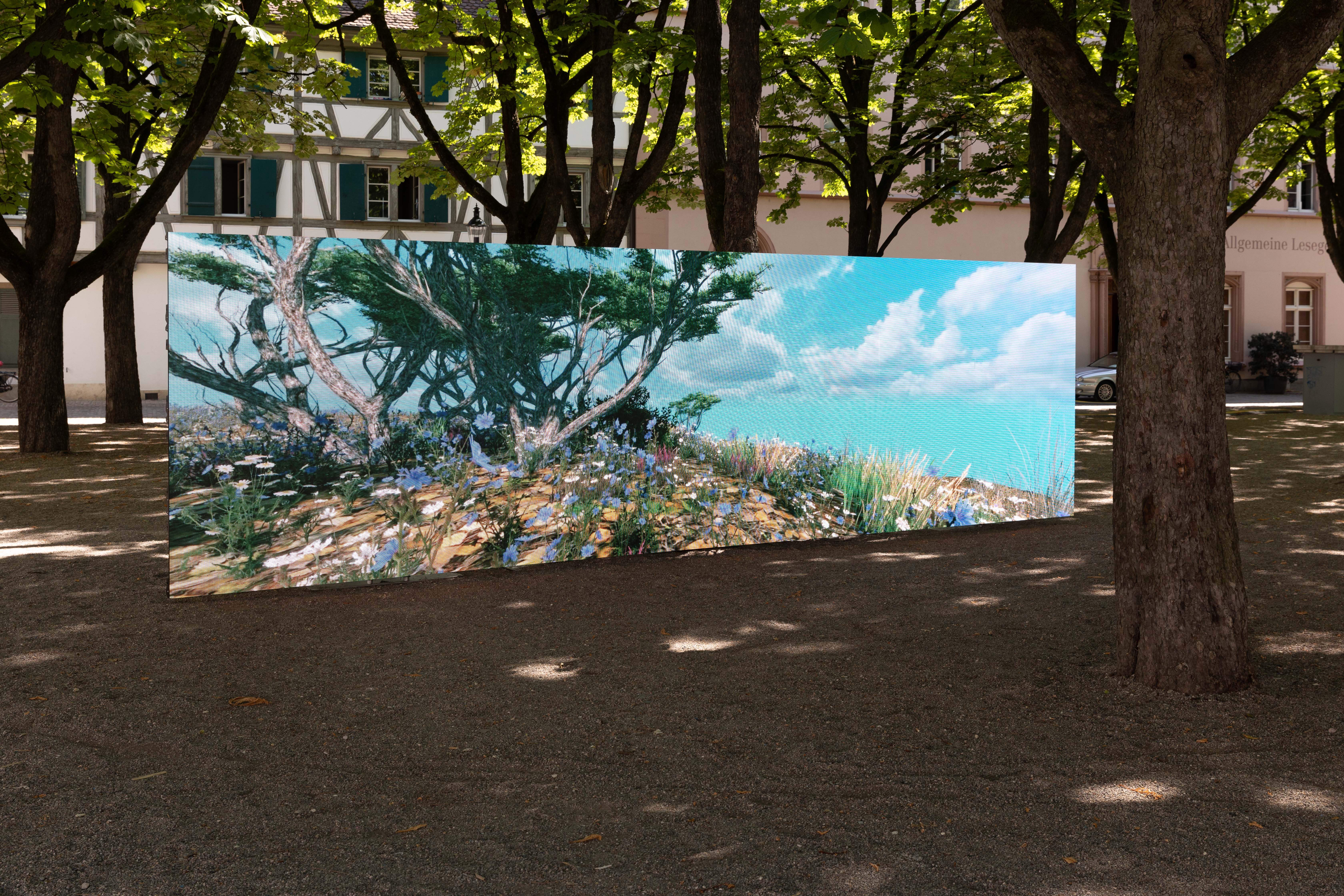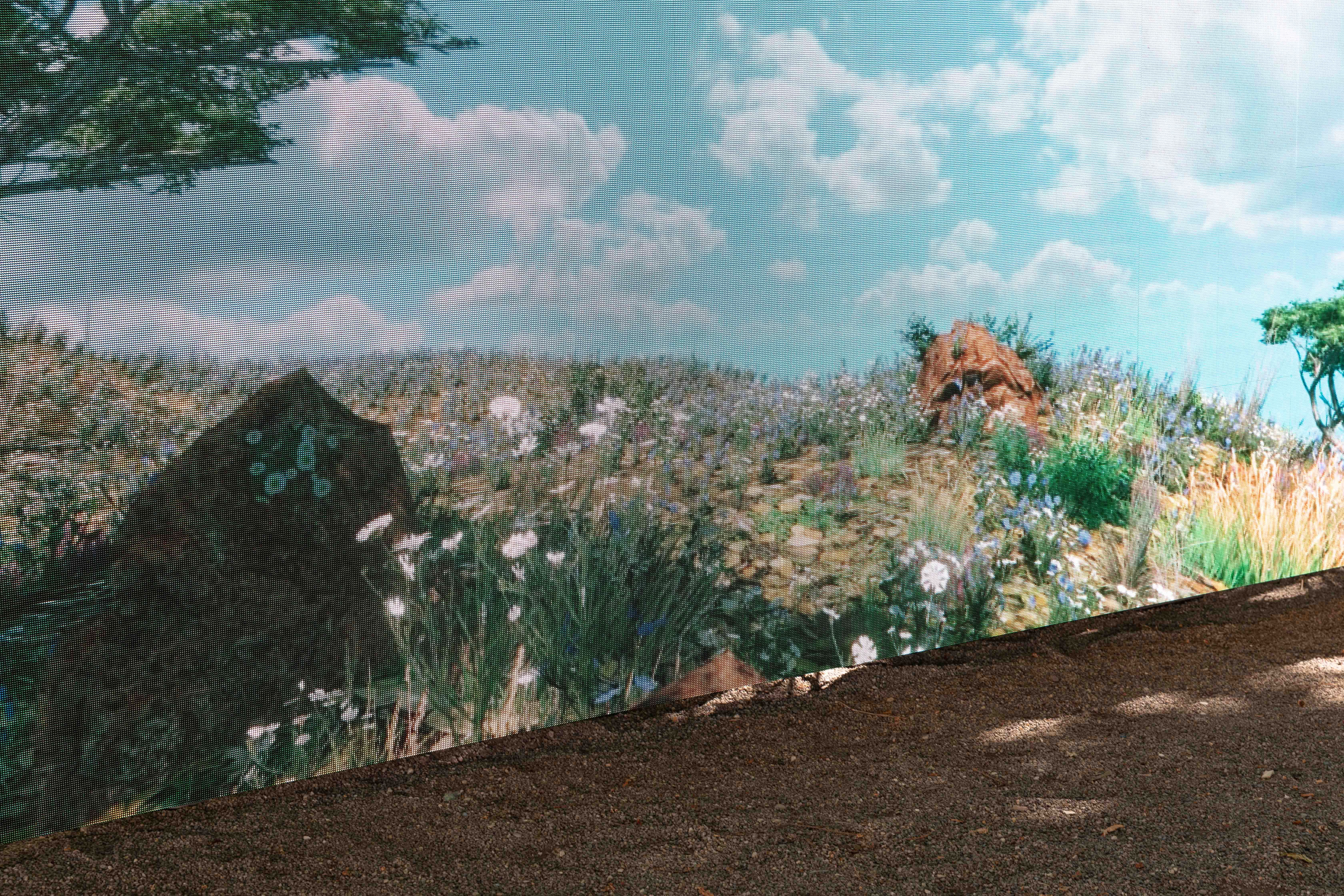Art Basel Parcours
Presented by Société, Berlin,
and Foxy Production, New York 16 June 2023 - 19 June 2023
We are pleased to premiere Petra Cortright’s new single-channel video work, “green hill green light esprit de corps," on Münsterplatz, Basel, as part of Art Basel Parcours. Curated by Samuel Leuenberger.
Petra Cortright’s digital paintings and videos combine expansive and seemingly limitless layers of information found while surfing on the internet. She is less concerned with the content of her source materials than the colors, surfaces, and textures that she finds there. Many of the artist’s works exhibit an affinity with the American West. “Growing up in California,” she explains, “I have a West Coast color palette, and, in some works, I try to achieve the depth and vastness that is present in the landscapes here. You can see for miles and miles; there are huge mountains and a big ocean, and a lot of different biomes. All of these things seeped into my brain, and it shows up in my aesthetics.”
Over the course of 17-minutes,“green hill green light esprit de corps" depicts a perpetually metamorphosing computer-generated landscape. Slow, infinitesimal movements populate an isolated hill with sprouting shrubs and flowers nurtured by gentle rain showers. This bucolic scene is relentlessly scanned by a roving digital eye that tracks through the chaparral, leaves, and grasses from a worm’s eye perspective. This surreal panorama is in constant motion: rhythmic pans across this verdant expanse of ground give way to suspended plant life, earth becomes plasticine sky, and our perspective seamlessly glides above and below the surface of an endlessly mutating landscape. This geographically impossible mashup collapses hills, water, and sky into one dynamic composition that is at once ethereal and unsettling, subtly gesturing towards the ravaged political and physical landscapes of the American West.
Reckless Bloom:
On Petra Cortright’s Shuddering Landscapes
Kate Brown
It is said that a significant marker of climate apocalypse will be madness pervading the seasons, a kind of riptide devouring natural logic and shifting the lengths of the mete-orological calendar. In her new video work, American artist Petra Cortright’s pastiched landscapes defy the assumed order of ecosystems, conveying a low-level anxiety that one might feel when the weather stops making sense. But her crafted scenes also come with a sense of relief. The piece, called green hill green light esprit de corps, is laced with optimism and freedom.
As is well-evidenced in her ongoing art practice, Cortright is invested in the history of painting. Her scenes recall a continuity of painters throughout history who have tackled nature as subject matter and our own fragility in its grip. To beat back against this notion, painters interpreted the natural with touches of surrealism as Cortright does here. Think of Caspar David Friedrich’s The Sea of Ice from 1823, a work edging on the surreal so much so that it confounded audiences at the time. That kind of Romantic feeling swirls through the artist’s filmed landscape.
This cannot be real, not for a moment. When writing about modernist painting, art critic Clement Greenberg described how the Impressionists left “the eye under no doubt as to the fact that the colours used were made of real paint that came from pots and tubes.” 1Similarly, Cortright leaves digital details out in the open for us. Low-res grittiness recalls that her pot and tube is a Wacom tablet and downloaded digital brush sets. And that “utter flatness” of modernist traditions that Greenberg croons about is embraced too, via FlowScape and Photoshop. Cortright’s hand is obviously present, meandering, searching, and testing boundaries across bucolic scenery. But is it a creator or a witness? This question haunts the video as we gaze at the blank undersides of daisies catching lens flares.
Disparate foliage is yoked together: we meet a ground of dead leaves but there are no trees from which they fell. The forest floor is like a desktop background, a kind of catchment basin for things nature shrugs off. And it gets wiped out sooner or later, subsumed under the surface and into the bin of earth underneath. The decaying leaves are cut against a bright sky, and they shift under cloud shadows. The limitlessness of the blue is dizzying and this delicate patch of earth teeters between states of birth and nonexistence. Exotic shells bloom in ashy earth. Daisies and cornflowers explode from a rootless, untethered surface.
Cortright’s flowers have a noted stillness even when they pop up from the thin pixel relief. This begs another question: Are we looking at landscape painting or something more akin to still life? I am thinking of what the influential American art historian Norman Bryson noted about Dutch still life painting in particular, a movement that brought together nature from all corners of the world into the space of single paintings. In these works, few connections between the natural objects presented existed. Bryson notes this, adding that “when the framework of space and time is effectively neutralised, there is an elevation of human powers over creatural limitation.” In such paintings, he notes, “lurks a certain Faustian ambition.”2 Empty shells from different oceans collapse distance, and flowers from far-off lands result in, as he puts it, the “abolition of place.”
This kind of power taken up by artists was exciting and provocative then as it is now, but we have different tools. Pioneering artists working in the 16th century could not have imagined how flat and stacked the pictorial world would become as it does in Cortrights’s depicted terrain.n
As an artist based in the American West, Cortright has, by osmosis, inherited awareness of distressed ecosystems. The pictorial plane of green hill green light esprit du corps borrows from land-use studies, those diagrams that show controlled flows of water, which map out a controlled forest burn in an attempt to fend off a real one. In such illustrations, multiple scenarios play out at once. And similarly, in Cortright’s 17-minute film, the viewer witnesses a perplexing conundrum of scenarios: cumulus clouds hang above the sun-filled ground and it is also drizzling and it is simultaneously storming. Everything is growing, degrading, and regenerating. A closed loop.
What can we understand from our scientific, artistic, and technological attempts to get to know nature? On some level, pursuits of making sense of things have always been pretty futile. Nothing is inherently important, it’s all about vibe. We have always been at the whim of the world. And so, the artist searches for meaning, or at least beauty, in their work. In Cortright’s case, the hunt is across a delicately rendered map, though it may be better understood as a mind map. The artist searches, maybe, for something like spring. Soon we are panning away from this mirage-like landscape—our anxiety ebbing and flowing as we try to rationalise an irrational place. One may hear the fading echo Rainer Maria Rilke, who captured most perfectly, that seasonal, desperate wonder of the world:
“Everything is blooming most recklessly; if it were voices instead of colours, there would be an unbelievable shrieking into the heart of the night.”
Petra Cortright makes art in traditional genres, such as landscape and portraiture, using tools, sources, formats, and platforms native to the age of the internet and digital technology. During the early 2000s, she captured the attention of the art world with a series of self-portrait videos that demonstrated unconventional uses of standard special effects. Petra also makes digital paintings printed on aluminum, linen, and paper. These paintings evoke the work of the Impressionists and other plein air painters, but she sources her imagery online, using the internet as a stand-in for nature. These works, nonetheless, exert a powerful physical presence. As she puts it, “While the work originates from an endless digital realm, my decision to ‘save as’ finalizes the painting and gives it a unique place in the ‘real world’ forever. I have a deep love of physical things and physical spaces.”
Petra Cortright (Santa Barbara, CA, 1986) lives and works in Los Angeles, CA. She studied Fine Arts at Parsons School of Design, The New School, New York, NY (2008), and at the California College of the Arts, San Francisco, CA (2004).
Exhibitions include: Petra Cortright: “sapphire cinnamon viper fairy,” Palm Springs Art Musum, CA (solo) (2022-2023); “Search Engines,” MoMA, New York, NY (2021-2023); “.paint,” MCA, Chicago, IL (2020); “The Body Electric,” Walker Art Center, Minneapolis, MN, toured to the Yerba Buena Center for the Arts, San Francisco, CA, and Miami Dade College Galleries of Art + Design, FL (2019-2021); “Dirty Protest: Selections from the Hammer,” Hammer Museum, Los Angeles, CA; “Now Playing: Video 1999-2019,” Scottsdale Museum of Contemporary Art, AZ; “Hate Speech: Aggression and Imitation,” Künstlerhaus, Halle für Kunst & Medien, Graz, Austria (all 2019): “I Was Raised On the Internet,” MCA, Chicago, IL (2018); “RUNNING NEO-GEO GAMES UNDER MAME,” City Gallery, Wellington, New Zealand (solo) (2017); “Electronic Superhighway,” Whitechapel Gallery, London, UK (2016); and “NIKI, LUCY, LOLA, VIOLA,” Depart Foundation, Los Angeles, CA (solo)(2015).
Public projects have included commissions from Frank Gehry Partners, LLP; Midnight Moment, Times Square Arts, New York, NY; Art on theMART, Chicago, IL (all 2019); and SketchedSpace in Seoul, South Korea (2018.)



